warning SUZUKI XL7 2007 2.G Owner's Manual
[x] Cancel search | Manufacturer: SUZUKI, Model Year: 2007, Model line: XL7, Model: SUZUKI XL7 2007 2.GPages: 274, PDF Size: 6.12 MB
Page 33 of 274

1-21 SEATS AND RESTRAINT SYSTEMS
78J00-03E
The restraint manufacturer’s instructions
that come with the restraint state the
weight and height limitations for a particu-
lar child restraint. In addition, there are
many kinds of restraints available for chil-
dren with special needs.
Child Restraint Systems
1379317
An infant car bed (A), a special bed made
for use in a motor vehicle, is an infant
restraint system designed to restrain or
position a child on a continuous flat sur-
face. Make sure that the infant’s head rests
toward the center of the vehicle.
WARNING
Newborn infants need complete sup-
port, including support for the head
and neck. This is necessary because
a newborn infant’s neck is weak and
its head weighs so much compared
with the rest of its body. In a crash,
an infant in a rear-facing seat settles
into the restraint, so the crash forces
can be distributed across the stron-
gest part of an infant’s body, the back
and shoulders. Infants always should
be secured in appropriate infant
restraints.
WARNING
The body structure of a young child
is quite unlike that of an adult or
older child, for whom the safety belts
are designed. A young child’s hip
bones are still so small that the vehi-
cle’s regular safety belt may not
remain low on the hip bones, as it
should. Instead, it may settle up
around the child’s abdomen. In a
crash, the belt would apply force on a
body area that is unprotected by any
bony structure. This alone could
cause serious or fatal injuries. Young
children always should be secured in
appropriate child restraints.
Page 35 of 274
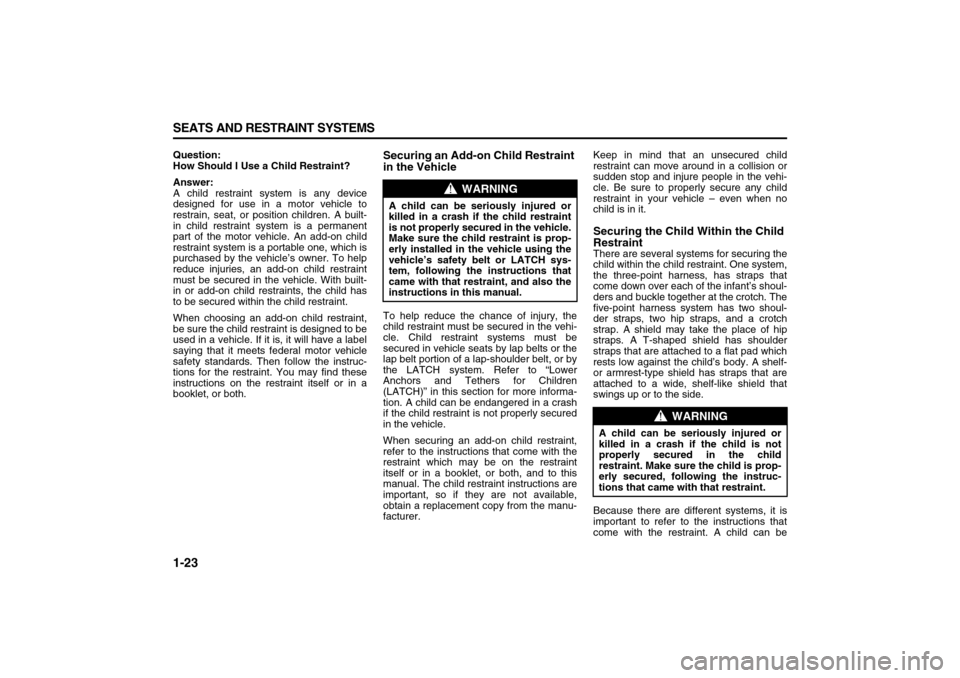
1-23 SEATS AND RESTRAINT SYSTEMS
78J00-03E
Question:
How Should I Use a Child Restraint?
Answer:
A child restraint system is any device
designed for use in a motor vehicle to
restrain, seat, or position children. A built-
in child restraint system is a permanent
part of the motor vehicle. An add-on child
restraint system is a portable one, which is
purchased by the vehicle’s owner. To help
reduce injuries, an add-on child restraint
must be secured in the vehicle. With built-
in or add-on child restraints, the child has
to be secured within the child restraint.
When choosing an add-on child restraint,
be sure the child restraint is designed to be
used in a vehicle. If it is, it will have a label
saying that it meets federal motor vehicle
safety standards. Then follow the instruc-
tions for the restraint. You may find these
instructions on the restraint itself or in a
booklet, or both.
Securing an Add-on Child Restraint
in the VehicleTo help reduce the chance of injury, the
child restraint must be secured in the vehi-
cle. Child restraint systems must be
secured in vehicle seats by lap belts or the
lap belt portion of a lap-shoulder belt, or by
the LATCH system. Refer to “Lower
Anchors and Tethers for Children
(LATCH)” in this section for more informa-
tion. A child can be endangered in a crash
if the child restraint is not properly secured
in the vehicle.
When securing an add-on child restraint,
refer to the instructions that come with the
restraint which may be on the restraint
itself or in a booklet, or both, and to this
manual. The child restraint instructions are
important, so if they are not available,
obtain a replacement copy from the manu-
facturer.Keep in mind that an unsecured child
restraint can move around in a collision or
sudden stop and injure people in the vehi-
cle. Be sure to properly secure any child
restraint in your vehicle – even when no
child is in it.
Securing the Child Within the Child
RestraintThere are several systems for securing the
child within the child restraint. One system,
the three-point harness, has straps that
come down over each of the infant’s shoul-
ders and buckle together at the crotch. The
five-point harness system has two shoul-
der straps, two hip straps, and a crotch
strap. A shield may take the place of hip
straps. A T-shaped shield has shoulder
straps that are attached to a flat pad which
rests low against the child’s body. A shelf-
or armrest-type shield has straps that are
attached to a wide, shelf-like shield that
swings up or to the side.
Because there are different systems, it is
important to refer to the instructions that
come with the restraint. A child can be
WARNING
A child can be seriously injured or
killed in a crash if the child restraint
is not properly secured in the vehicle.
Make sure the child restraint is prop-
erly installed in the vehicle using the
vehicle’s safety belt or LATCH sys-
tem, following the instructions that
came with that restraint, and also the
instructions in this manual.
WARNING
A child can be seriously injured or
killed in a crash if the child is not
properly secured in the child
restraint. Make sure the child is prop-
erly secured, following the instruc-
tions that came with that restraint.
Page 36 of 274
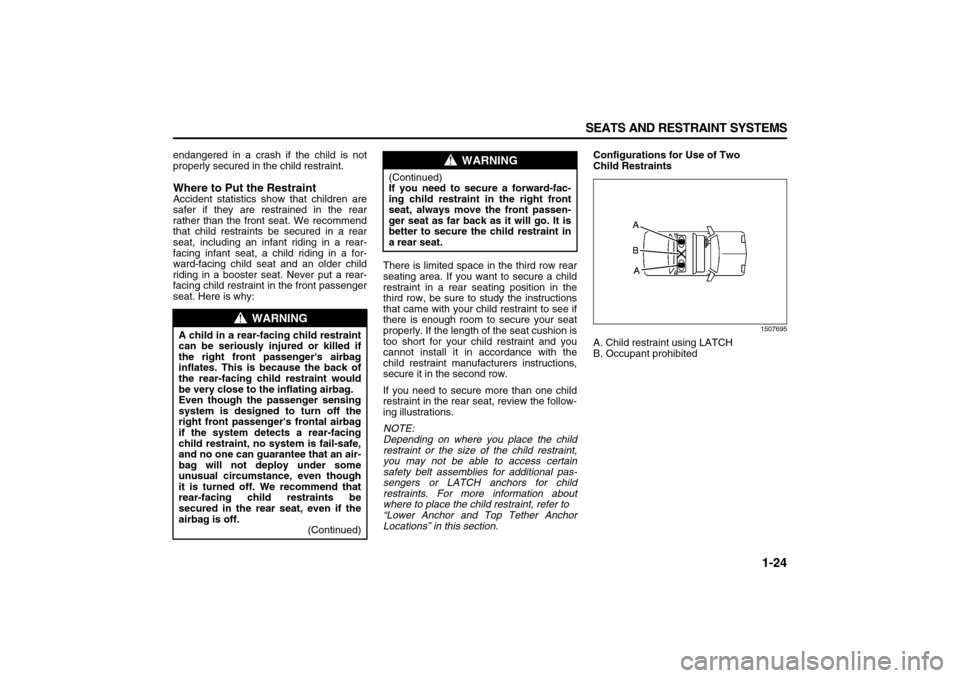
1-24 SEATS AND RESTRAINT SYSTEMS
78J00-03E
endangered in a crash if the child is not
properly secured in the child restraint.Where to Put the RestraintAccident statistics show that children are
safer if they are restrained in the rear
rather than the front seat. We recommend
that child restraints be secured in a rear
seat, including an infant riding in a rear-
facing infant seat, a child riding in a for-
ward-facing child seat and an older child
riding in a booster seat. Never put a rear-
facing child restraint in the front passenger
seat. Here is why:There is limited space in the third row rear
seating area. If you want to secure a child
restraint in a rear seating position in the
third row, be sure to study the instructions
that came with your child restraint to see if
there is enough room to secure your seat
properly. If the length of the seat cushion is
too short for your child restraint and you
cannot install it in accordance with the
child restraint manufacturers instructions,
secure it in the second row.
If you need to secure more than one child
restraint in the rear seat, review the follow-
ing illustrations.
NOTE:
Depending on where you place the child
restraint or the size of the child restraint,
you may not be able to access certain
safety belt assemblies for additional pas-
sengers or LATCH anchors for child
restraints. For more information about
where to place the child restraint, refer to
“Lower Anchor and Top Tether Anchor
Locations” in this section.Configurations for Use of Two
Child Restraints
1507695
A. Child restraint using LATCH
B. Occupant prohibited
WARNING
A child in a rear-facing child restraint
can be seriously injured or killed if
the right front passenger's airbag
inflates. This is because the back of
the rear-facing child restraint would
be very close to the inflating airbag.
Even though the passenger sensing
system is designed to turn off the
right front passenger's frontal airbag
if the system detects a rear-facing
child restraint, no system is fail-safe,
and no one can guarantee that an air-
bag will not deploy under some
unusual circumstance, even though
it is turned off. We recommend that
rear-facing child restraints be
secured in the rear seat, even if the
airbag is off.
(Continued)
WARNING
(Continued)
If you need to secure a forward-fac-
ing child restraint in the right front
seat, always move the front passen-
ger seat as far back as it will go. It is
better to secure the child restraint in
a rear seat.
Page 40 of 274

1-28 SEATS AND RESTRAINT SYSTEMS
78J00-03E
to Put the Restraint” in this section for
additional information.Securing a Child Restraint
Designed for the LATCH System
1252139
A. Passenger’s side rear seat lower
anchors
B. Center rear seat lower anchors
C. Driver’s side rear seat lower anchors
Make sure to attach the child restraint at
the proper anchor location.
This system is designed to make installa-
tion of child restraints easier. When using
lower anchors, do not use the vehicle’s
safety belts. Instead use the vehicle’s
anchors and child restraint attachments to
secure the restraints. Some restraints also
use another vehicle anchor to secure a top
tether.
1) Attach and tighten the lower attach-
ments to the lower anchors. If the child
restraint does not have lower attach-
ments or the desired seating position
does not have lower anchors, secure
WARNING
If a LATCH-type child restraint is not
attached to anchors, the restraint will
not be able to protect the child cor-
rectly. In a crash, the child could be
seriously injured or killed. Make sure
that a LATCH-type child restraint is
properly installed using the anchors,
or use the vehicle’s safety belts to
secure the restraint, following the
instructions that came with that
restraint, and also the instructions in
this manual.
WARNING
Each top tether anchor and lower
anchor in the vehicle is designed to
hold only one child restraint. Attach-
ing more than one child restraint to a
single anchor could cause the anchor
or attachment to come loose or even
break during a crash. A child or oth-
ers could be injured if this happens.
To help prevent injury to people and
damage to your vehicle, attach only
one child restraint per anchor.
WARNING
Children can be seriously injured or
strangled if a shoulder belt is
wrapped around their neck and the
safety belt continues to tighten.
Secure any unused safety belts
behind the child restraint so children
cannot reach them. Pull the shoulder
belt all the way out of the retractor to
set the lock, if your vehicle has one,
after the child restraint has been
installed. Be sure to follow the
instructions of the child restraint
manufacturer.
CAUTION
Contact between the child restraint or
the LATCH attachment parts and the
vehicle’s safety belt assembly may
cause damage to these parts. Make
sure when securing unused safety
belts behind the child restraint that
there is no contact between the child
restraint or the LATCH attachment
parts and the vehicle’s safety belt
assembly.
Folding an empty rear seat with the
safety belts secured may cause dam-
age to the safety belt or the seat.
When removing the child restraint,
always remember to return the safety
belts to their normal, stowed position
before folding the rear seat.
Page 43 of 274

1-31 SEATS AND RESTRAINT SYSTEMS
78J00-03E
Securing a Child Restraint in the
Right Front Seat PositionYour vehicle has a right front passenger's
airbag. A rear seat is a safer place to
secure a forward-facing child restraint.
Refer to “Where to Put the Restraint” in
this section.
In addition, your vehicle has a passenger
sensing system. The passenger sensing
system is designed to turn off the right
front passenger’s frontal airbag when an
infant in a rear-facing infant seat or a small
child in a forward-facing child restraint or
booster seat is detected. Refer to “Passen-
ger Sensing System” in this section and
“Passenger Airbag Status Indicator” in
“Warning Lights, Gages, and Indicators” in
the “Instrument Panel” section for more
information on this including important
safety information.
A label on your sun visor says, “Never put
a rear-facing child seat in the front.” This is
because the risk to the rear-facing child is
so great, if the airbag deploys.
If your vehicle does not have a rear seat
that will accommodate a rear-facing child
restraint, never put a child in a rear-facing
child restraint in the right front passenger
seat unless the passenger airbag status
indicator shows off and the airbag is off.
Here is why:If you need to secure a forward-facing
child restraint in the right front seat posi-
tion, move the seat as far back as it will go
before securing the forward-facing child
WARNING
A child in a rear-facing child restraint
can be seriously injured or killed if
the right front passenger's airbag
inflates. This is because the back of
the rear-facing child restraint would
be very close to the inflating airbag.
Even though the passenger sensing
system is designed to turn off the
right front passenger's frontal airbag
if the system detects a rear-facing
child restraint, no system is fail-safe,
and no one can guarantee that an air-
bag will not deploy under some
unusual circumstance, even though it
is turned off. We recommend that
rear-facing child restraints be
secured in the rear seat, even if the
airbag is off.
If you need to secure a forward-fac-
ing child restraint in the right front
seat, always move the front passen-
ger seat as far back as it will go. It is
better to secure the child restraint in
a rear seat.
WARNING
A child in a rear-facing child restraint
can be seriously injured or killed if
the right front passenger's airbag
inflates. This is because the back of
the rear-facing child restraint would
be very close to the inflating airbag.
Be sure the airbag is off before using
a rear-facing child restraint in the
right front seat position.
Even though the passenger sensing
system is designed to turn off the
passenger's frontal airbag if the sys-
tem detects a rear-facing child
restraint, no system is fail-safe, and
no one can guarantee that an airbag
will not deploy under some unusual
circumstance, even though it is
turned off. We recommend that rear-
facing child restraints be transported
in vehicles with a rear seat that will
accommodate a rear-facing child
restraint, whenever possible.
If you need to secure a forward-fac-
ing child restraint in the right front
seat, always move the front passen-
ger seat as far back as it will go. It is
better to secure the child restraint in
a rear seat.
Page 44 of 274
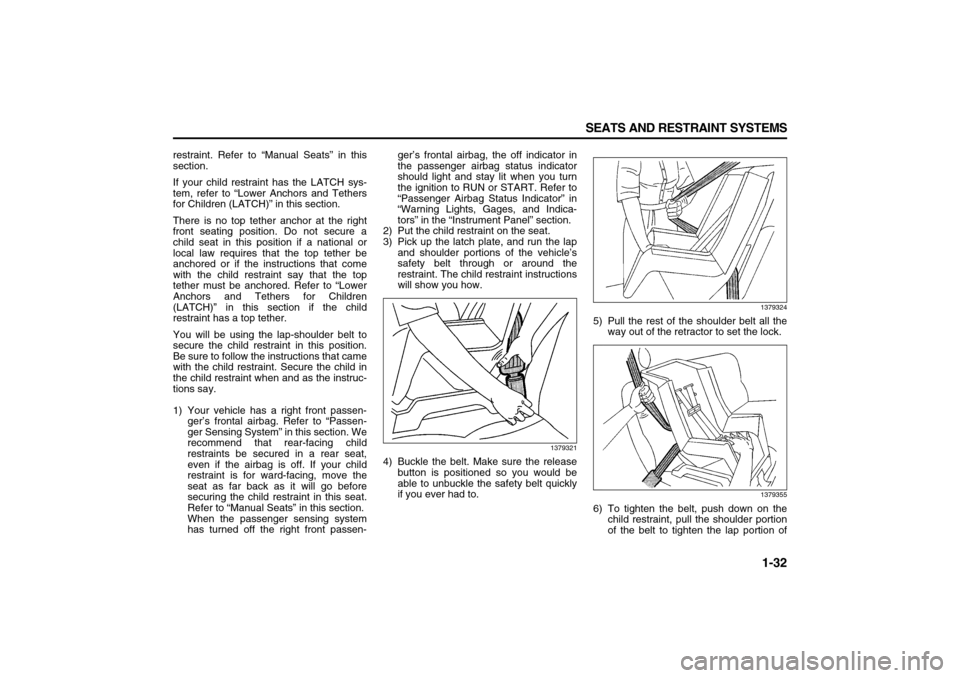
1-32 SEATS AND RESTRAINT SYSTEMS
78J00-03E
restraint. Refer to “Manual Seats” in this
section.
If your child restraint has the LATCH sys-
tem, refer to “Lower Anchors and Tethers
for Children (LATCH)” in this section.
There is no top tether anchor at the right
front seating position. Do not secure a
child seat in this position if a national or
local law requires that the top tether be
anchored or if the instructions that come
with the child restraint say that the top
tether must be anchored. Refer to “Lower
Anchors and Tethers for Children
(LATCH)” in this section if the child
restraint has a top tether.
You will be using the lap-shoulder belt to
secure the child restraint in this position.
Be sure to follow the instructions that came
with the child restraint. Secure the child in
the child restraint when and as the instruc-
tions say.
1) Your vehicle has a right front passen-
ger’s frontal airbag. Refer to “Passen-
ger Sensing System” in this section. We
recommend that rear-facing child
restraints be secured in a rear seat,
even if the airbag is off. If your child
restraint is for ward-facing, move the
seat as far back as it will go before
securing the child restraint in this seat.
Refer to “Manual Seats” in this section.
When the passenger sensing system
has turned off the right front passen-ger’s frontal airbag, the off indicator in
the passenger airbag status indicator
should light and stay lit when you turn
the ignition to RUN or START. Refer to
“Passenger Airbag Status Indicator” in
“Warning Lights, Gages, and Indica-
tors” in the “Instrument Panel” section.
2) Put the child restraint on the seat.
3) Pick up the latch plate, and run the lap
and shoulder portions of the vehicle’s
safety belt through or around the
restraint. The child restraint instructions
will show you how.
1379321
4) Buckle the belt. Make sure the release
button is positioned so you would be
able to unbuckle the safety belt quickly
if you ever had to.
1379324
5) Pull the rest of the shoulder belt all the
way out of the retractor to set the lock.
1379355
6) To tighten the belt, push down on the
child restraint, pull the shoulder portion
of the belt to tighten the lap portion of
Page 46 of 274

1-34 SEATS AND RESTRAINT SYSTEMS
78J00-03E
WARNING
You can be severely injured or killed
in a crash if you are not wearing your
safety belt – even if you have airbags.
Wearing your safety belt during a
crash helps reduce your chance of
hitting things inside the vehicle or
being ejected from it. Airbags are
“supplemental restraints” to the
safety belts. All airbags are designed
to work with safety belts but do not
replace them.
Frontal airbags for the driver and
right front passenger are designed to
deploy in moderate to severe frontal
and near frontal crashes. They are
not designed to inflate in rollover,
rear crashes, or in many side
crashes. And, for some unrestrained
occupants, frontal airbags may pro-
vide less protection in frontal
crashes than more forceful airbags
have provided in the past.
(Continued)
WARNING
(Continued)
Roof-mounted rollover airbags are
designed to inflate in moderate to
severe crashes where something hits
the side of your vehicle, during a
vehicle rollover, or in a severe frontal
impact. They are not designed to
inflate in rear crashes. If your vehicle
has roof-mounted airbags, they are
designed to provide both side impact
protection and rollover protection.
Everyone in your vehicle should wear
a safety belt properly – whether or
not there is an airbag for that person.
WARNING
Both frontal and roof-mounted roll-
over airbags inflate with great force,
faster than the blink of an eye. If you
are too close to an inflating airbag, as
you would be if you were leaning for-
ward, it could seriously injure you.
Safety belts help keep you in position
for airbag inflation before and during
a crash. Always wear your safety belt
even with frontal airbags. The driver
should sit as far back as possible
while still maintaining control of the
vehicle. Occupants should not lean
on or sleep against the door in the
first or second row seats, or the rear
windows in the third row seat, if your
vehicle has roof-mounted rollover air-
bags.
Page 47 of 274
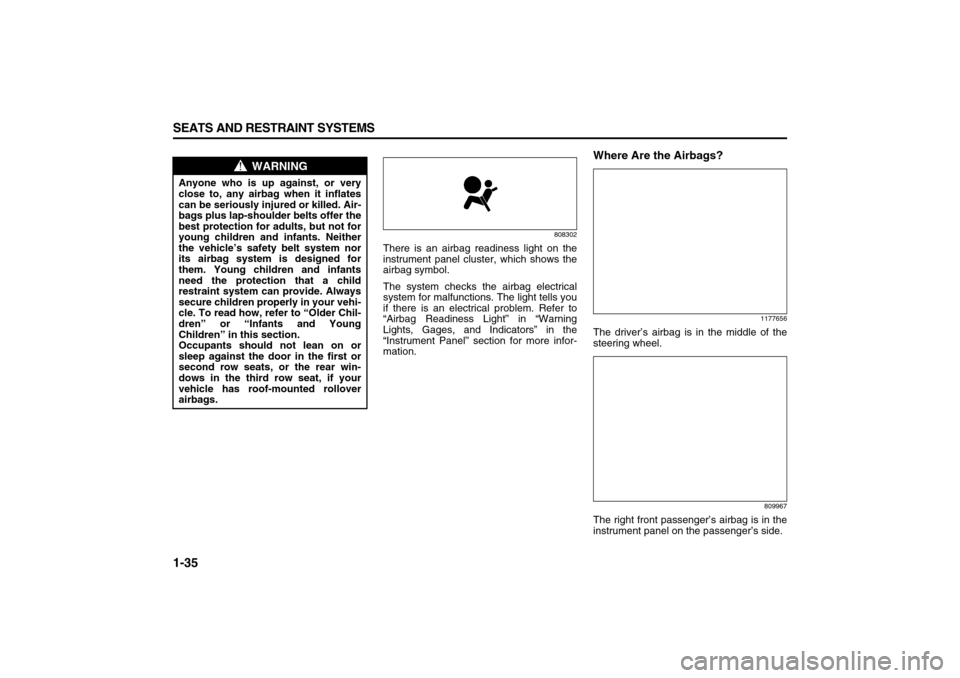
1-35 SEATS AND RESTRAINT SYSTEMS
78J00-03E
808302
There is an airbag readiness light on the
instrument panel cluster, which shows the
airbag symbol.
The system checks the airbag electrical
system for malfunctions. The light tells you
if there is an electrical problem. Refer to
“Airbag Readiness Light” in “Warning
Lights, Gages, and Indicators” in the
“Instrument Panel” section for more infor-
mation.
Where Are the Airbags?
1177656
The driver’s airbag is in the middle of the
steering wheel.
809967
The right front passenger’s airbag is in the
instrument panel on the passenger’s side.
WARNING
Anyone who is up against, or very
close to, any airbag when it inflates
can be seriously injured or killed. Air-
bags plus lap-shoulder belts offer the
best protection for adults, but not for
young children and infants. Neither
the vehicle’s safety belt system nor
its airbag system is designed for
them. Young children and infants
need the protection that a child
restraint system can provide. Always
secure children properly in your vehi-
cle. To read how, refer to “Older Chil-
dren” or “Infants and Young
Children” in this section.
Occupants should not lean on or
sleep against the door in the first or
second row seats, or the rear win-
dows in the third row seat, if your
vehicle has roof-mounted rollover
airbags.
Page 49 of 274

1-37 SEATS AND RESTRAINT SYSTEMS
78J00-03E
When Should an Airbag Inflate?The driver’s and right front passenger’s
frontal airbags are designed to inflate in
moderate to severe frontal or near-frontal
crashes. But they are designed to inflate
only if the impact exceeds a predetermined
deployment threshold. Deployment thresh-
olds take into account a variety of desired
deployment and non-deployment events
and are used to predict how severe a crash
is likely to be in time for the airbags to
inflate and help restrain the occupants.
Whether your frontal airbags will or shoulddeploy is not based on how fast your vehi-
cle is traveling. It depends largely on what
you hit, the direction of the impact and how
quickly your vehicle slows down.
In addition, your vehicle has “dual-stage”
frontal airbags, which adjust the restraint
according to crash severity. Your vehicle
has electronic frontal sensors which help
the sensing system distinguish between a
moderate frontal impact and a more severe
frontal impact. For moderate frontal
impacts, these airbags inflate at a level
less than full deployment. For more severe
frontal impacts, full deployment occurs. If
the front of your vehicle goes straight into a
wall that does not move or deform, the
threshold level for the reduced deployment
is about 11 to 16 mph (17 to 26 km/h), and
the threshold level for a full deployment is
about 20 to 25 mph (32 to 40 km/h). The
threshold level can vary, however, with
specific vehicle design, so that it can be
somewhat above or below this range.
Frontal airbags may inflate at different
crash speeds. For example:
If the vehicle hits a stationary object, the
airbags could inflate at a different crash
speed than if the vehicle hits a moving
object.
If the vehicle hits an object that deforms,
the airbags could inflate at a different
crash speed than if the vehicle hits an
object that does not deform. If the vehicle hits a narrow object (like a
pole) the airbags could inflate at a differ-
ent crash speed than if the vehicle hits a
wide object (like a wall).
If the vehicle goes into an object at an
angle the airbags could inflate at a differ-
ent crash speed than if the vehicle goes
straight into the object.
The frontal airbags (driver and right front
passenger) are not intended to inflate dur-
ing vehicle rollovers, rear impacts, or in
many side impacts.
Your vehicle has roof-mounted rollover air-
bags and a rollover sensor. Refer to “Air-
bag System” in this section. These
“rollover capable” airbags are intended to
inflate in moderate to severe side crashes,
during a rollover or in a severe frontal
impact. A roof-mounted rollover airbag will
inflate if the crash severity is above the
system’s designed “threshold level.” The
threshold level can vary with specific vehi-
cle design. Roof-mounted rollover airbags
are not intended to inflate in rear impacts.
Both roof-mounted rollover airbags will
deploy when either side of the vehicle is
struck or during a rollover, or in a severe
frontal impact.
In any particular crash, no one can say
whether an airbag should have inflated
simply because of the damage to a vehicle
or because of what the repair costs were.
For frontal airbags, inflation is determined
by what the vehicle hits, the angle of the
WARNING
If something is between an occupant
and an airbag, the bag might not
inflate properly or it might force the
object into that person causing
severe injury or even death. The path
of an inflating airbag must be kept
clear. Do not put anything between
an occupant and an airbag, and do
not attach or put anything on the
steering wheel hub or on or near any
other airbag covering. And, if your
vehicle has roof-mounted rollover
airbags, never secure anything to the
roof of your vehicle by routing the
rope or tie down through any door or
window opening. If you do, the path
of an inflating side impact airbag will
be blocked. The path of an inflating
airbag must be kept clear.
Page 50 of 274
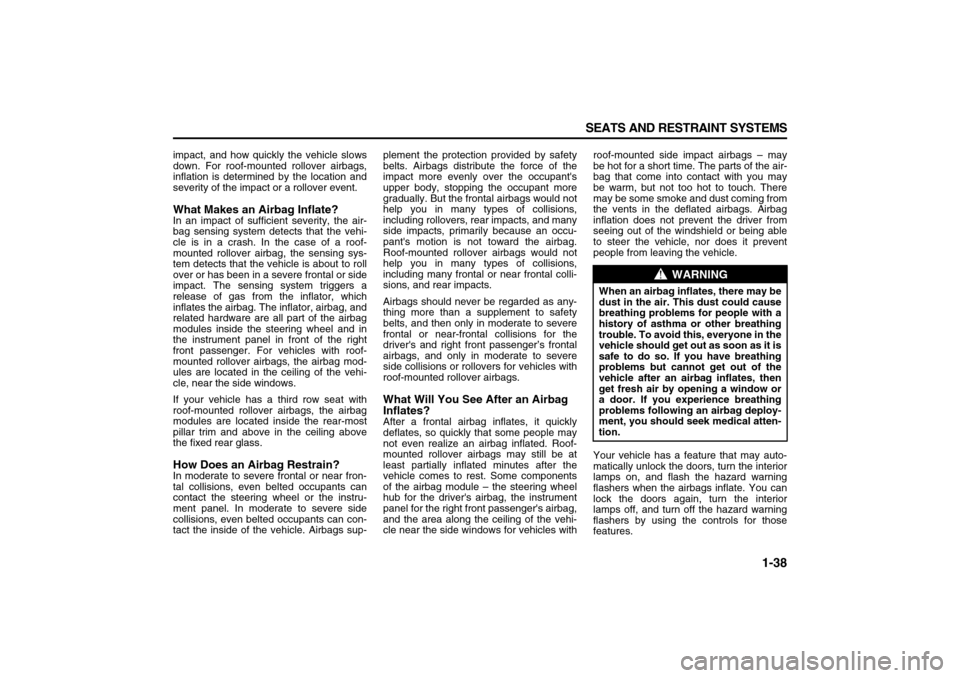
1-38 SEATS AND RESTRAINT SYSTEMS
78J00-03E
impact, and how quickly the vehicle slows
down. For roof-mounted rollover airbags,
inflation is determined by the location and
severity of the impact or a rollover event.What Makes an Airbag Inflate?In an impact of sufficient severity, the air-
bag sensing system detects that the vehi-
cle is in a crash. In the case of a roof-
mounted rollover airbag, the sensing sys-
tem detects that the vehicle is about to roll
over or has been in a severe frontal or side
impact. The sensing system triggers a
release of gas from the inflator, which
inflates the airbag. The inflator, airbag, and
related hardware are all part of the airbag
modules inside the steering wheel and in
the instrument panel in front of the right
front passenger. For vehicles with roof-
mounted rollover airbags, the airbag mod-
ules are located in the ceiling of the vehi-
cle, near the side windows.
If your vehicle has a third row seat with
roof-mounted rollover airbags, the airbag
modules are located inside the rear-most
pillar trim and above in the ceiling above
the fixed rear glass.How Does an Airbag Restrain?In moderate to severe frontal or near fron-
tal collisions, even belted occupants can
contact the steering wheel or the instru-
ment panel. In moderate to severe side
collisions, even belted occupants can con-
tact the inside of the vehicle. Airbags sup-plement the protection provided by safety
belts. Airbags distribute the force of the
impact more evenly over the occupant's
upper body, stopping the occupant more
gradually. But the frontal airbags would not
help you in many types of collisions,
including rollovers, rear impacts, and many
side impacts, primarily because an occu-
pant's motion is not toward the airbag.
Roof-mounted rollover airbags would not
help you in many types of collisions,
including many frontal or near frontal colli-
sions, and rear impacts.
Airbags should never be regarded as any-
thing more than a supplement to safety
belts, and then only in moderate to severe
frontal or near-frontal collisions for the
driver's and right front passenger’s frontal
airbags, and only in moderate to severe
side collisions or rollovers for vehicles with
roof-mounted rollover airbags.
What Will You See After an Airbag
Inflates?After a frontal airbag inflates, it quickly
deflates, so quickly that some people may
not even realize an airbag inflated. Roof-
mounted rollover airbags may still be at
least partially inflated minutes after the
vehicle comes to rest. Some components
of the airbag module – the steering wheel
hub for the driver's airbag, the instrument
panel for the right front passenger's airbag,
and the area along the ceiling of the vehi-
cle near the side windows for vehicles withroof-mounted side impact airbags – may
be hot for a short time. The parts of the air-
bag that come into contact with you may
be warm, but not too hot to touch. There
may be some smoke and dust coming from
the vents in the deflated airbags. Airbag
inflation does not prevent the driver from
seeing out of the windshield or being able
to steer the vehicle, nor does it prevent
people from leaving the vehicle.
Your vehicle has a feature that may auto-
matically unlock the doors, turn the interior
lamps on, and flash the hazard warning
flashers when the airbags inflate. You can
lock the doors again, turn the interior
lamps off, and turn off the hazard warning
flashers by using the controls for those
features.
WARNING
When an airbag inflates, there may be
dust in the air. This dust could cause
breathing problems for people with a
history of asthma or other breathing
trouble. To avoid this, everyone in the
vehicle should get out as soon as it is
safe to do so. If you have breathing
problems but cannot get out of the
vehicle after an airbag inflates, then
get fresh air by opening a window or
a door. If you experience breathing
problems following an airbag deploy-
ment, you should seek medical atten-
tion.